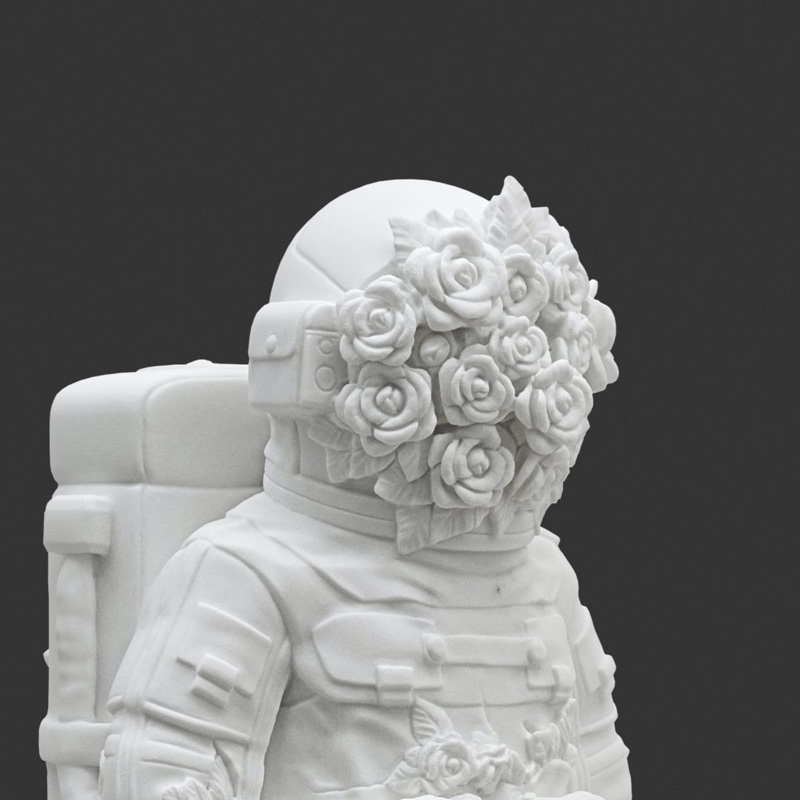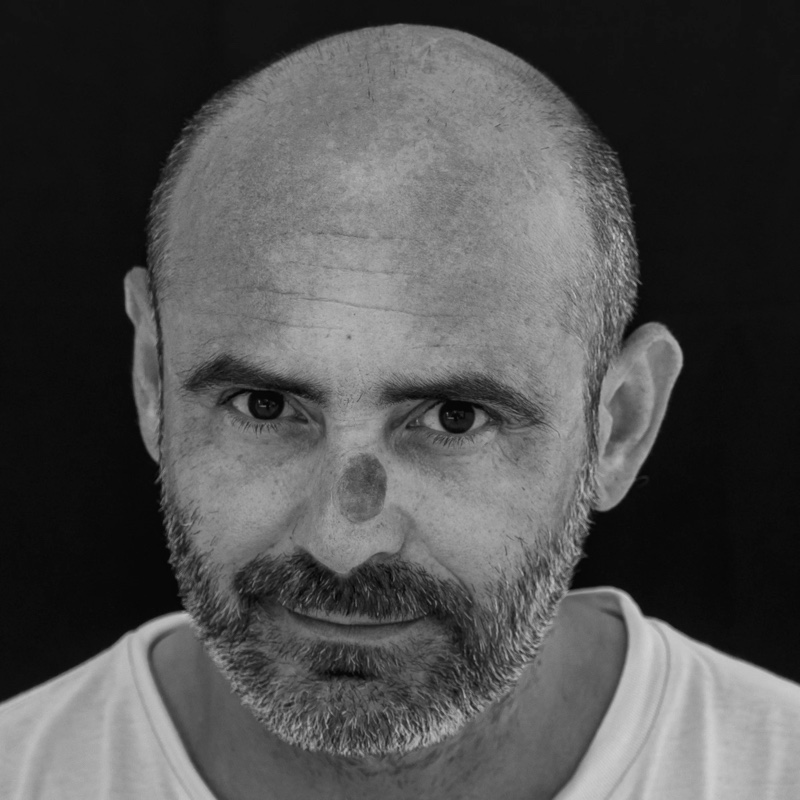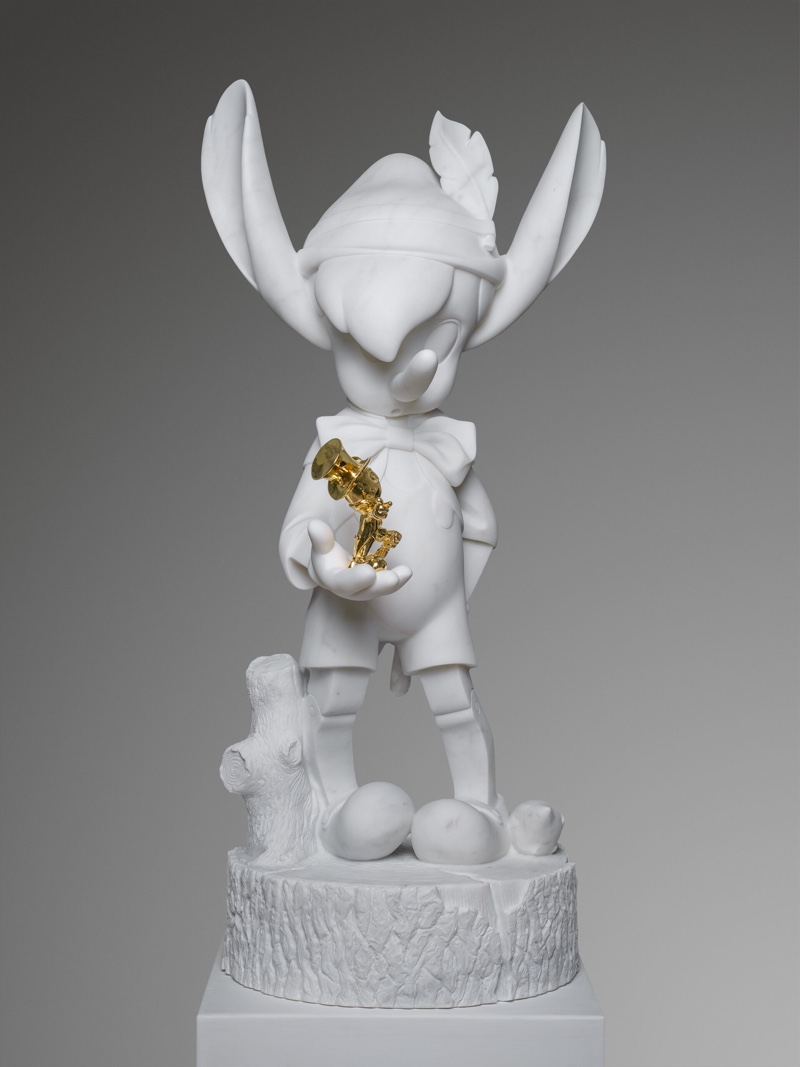
Filippo Tincolini, Spaceman, 2022.
In the artistic landscape of Carrara, a world-renowned center for the quality of its marble, Filippo Tincolini’s workshop emerges as a unique meeting point between the ancient art of sculpture and the technological vanguard. Since 2004, when Tincolini opened this space, the workshop has become a place of continuous experimentation and innovation.
FILIPPO TINCOLINI’S WORKSHOP IN CARRARA

Filippo Tincolini, a native of Pontedera, chose Carrara not only as his home, but as a source of inspiration and raw material for his works. Through deep and constant dialogue with local artisans and immersion in the history of marble quarries, the artist has been able to deepen his understanding of the chemical and aesthetic qualities of marble, exploring the limits of this noble and durable material and pushing its expressive potential beyond traditional sculptural techniques.
In describing the philosophy of his workshop, Tincolini stresses the importance of a synthesis between respect for tradition and openness to innovation. “My art is born from the balance between the aesthetic rigor of classical canons and the aspiration toward the unprecedented,” the artist says. This balance is clearly manifested in his workshop, conceived not only as a space for sculpture but also as a center for research and development that embraces architecture and restoration, collaborating with a vast network of international artists, museums, and design studios.
Filippo Tincolini, a technology enthusiast and lover of freedom, blends art and lifestyle in an ongoing quest for innovation and expression.
In his works (https://www.filippotincolini.com/it/artworks/) he does not present us with absolute truths but takes responsibility for answering the questions we have always asked in our “being in the world.” He does this with irony and lightness to recover a ritual dimension, open to the other, break the self-referentiality of art and guide the viewer in reading the work.
In search of new “epiphanies,” Filippo Tincolini lives art as a search for dialogue through beauty, a visible expression of the good, as the good is the metaphysical condition of beauty. His works thus live from the encounter between aesthetic care, respecting the canons of classical sculpture and the millenary traditions of Carrara workshops, and the astonishment in front of something “other than us” that, coming to meet us, questions and interpellates us, offering us a possible way out of the labyrinth of life.
The workshop is distinguished by the advanced use of technologies such as 3-D laser scanning and the use of anthropomorphic robots that assist the sculptors in rough-hewing. These machines, initially created “in a garage among sculptures,” as the author recalls, have evolved to become an internationally recognized phenomenon in 2018. Despite their innovative capacity, they remain tools that, according to Tincolini, “in no way replace human intelligence, flair and creativity.”
Tincolini then manually intervenes in the details of his works, creating a dialogue between antiquity and contemporaneity. The sculptures often depict modern heroes, drawing from the collective imagination of cinema and comic books, and presenting mythological figures in contemporary contexts such as the Bust of Daedalus (2023), exemplifying this approach. Majestic and mysterious emerging from the depths of time are the sculptures in the “Ancient Gods” series where ancient art merges with contemporary superhero mythologies to bridge past and future. Fragments of heroism that speak of ancient battles and immortal values, powerful reminders of invincibility and human frailty.
In the “Swaddle” series, through the fusion of bandages and ropes with anatomical parts, the works stand as a cry of defiance and a hymn to the struggle for freedom. In “Flowered Soul” it is nature that reminds us of its existence by making its “way” through the bodies and astronaut suit of the Spacemen: life is here and not elsewhere!
But if the flowers advance silently, from the animals in the “Dystopian Animals” series a cry of alarm rises to denounce the incongruities and contradictions of our time and invoke a future in which art and humanity can still assert their ability to reinvent and heal our wounded world.
The works range in a variety of subjects, from mythical to fantastic and surreal characters such as astronauts with floral faces or penguins with life preservers. These subjects not only evoke reflection on the nature of heroism and human vulnerability but also invite consideration of the complexity of interactions between cultural ideals and their artistic representation.

Filippo Tincolini Pinocchio 2020
With these works, Tincolini does not seek to narrate an unambiguous truth, but rather to offer an alternative perspective on reality, as he himself states:
“Through sculpture, I explore the complexity of our world; I do not aspire to tell a definite truth, but to propose a narrative that offers new interpretations and possible escape routes from everyday reality.”
Filippo Tincolini’s workshop in Carrara remains a place where sculptural tradition blends harmoniously with technological innovation, creating a fertile ground for artistic experimentation and continuous dialogue between ancient and modern.
If we were to venture, we would speak of modal art, an art capable of narrating the plurality of modes (or styles) of thought because reality is not the only model of truth.
If you love the works of artists who manage to combine tradition and innovation, allpra you should also read the post dedicated to the works of Aldo Salucci, the artist who has found in photography and digital post-production his personal channel of expression.

